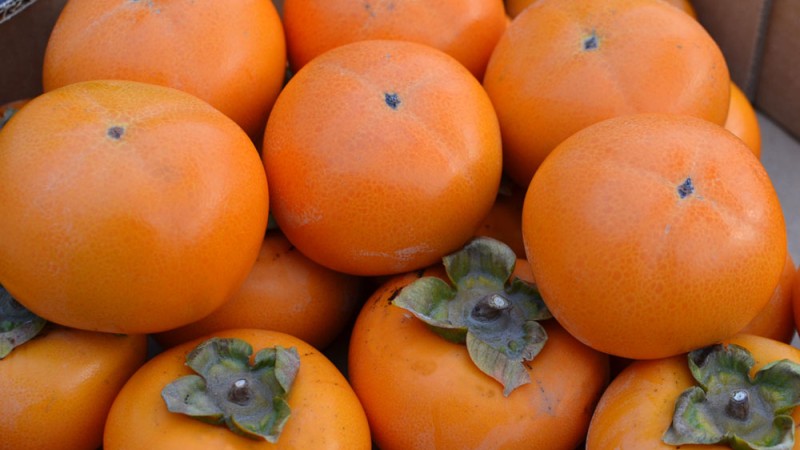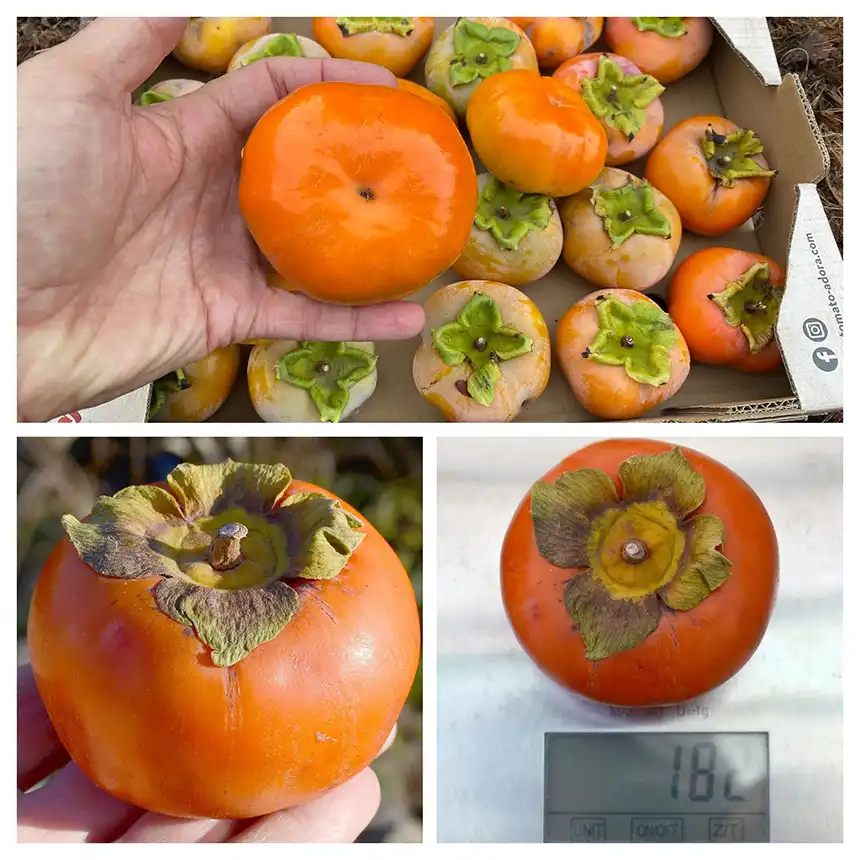
Diospyros is a genus of over 700 species of deciduous and evergreen trees and shrubs. The majority are native to the tropics, with only a few species extending into temperate regions. Individual species valued for their hard, heavy, dark timber, are commonly known as ebony trees, while others are valued for their fruit and known as Persimmon trees.
First, let's clarify the origin
Diospyros lotus, also known as Caucasian persimmon, is native to southwest Asia and southeast Europe. It is among the oldest species of the genus Diospyros in cultivation. It was known to the ancient Greeks as "God's fruit" Zeus fire (Διός πυρός, Diós purós), hence the scientific name of the genus. The tree grows in the lower and middle mountain zones up to 600 m above sea level and reaches heights of 15 – 30 m. The flowers are dioecious and cross-pollinated. The fruits ripen in October to November. They are small, 1–2 cm in diameter, yellow when ripe, and have juicy flesh and hard seeds. While unripe, the fruit is astringent, but this astringency disappears as the fruit matures and softens, or dry out. When ripe, it has a sweet taste reminiscent of both dates and plums.
Diospyros virginiana is a persimmon species commonly called the American persimmon. It ranges from southern Connecticut to Florida, and west to Texas, Louisiana, Oklahoma, Kansas, and Iowa. The tree grows in the wild but has long been cultivated by Native Americans for its fruit and wood. D. virginiana grows to a height of 20 m. The tree is typically dioecious, so one must have both male and female plants to obtain fruit. Most cultivars are parthenocarpic (setting seedless fruit without pollination). The fruit is round or oval, usually orange-yellow, sometimes bluish, and from 2 to 6 cm in diameter. A juicy flesh contains one to eight seeds. The astringency renders the fruit somewhat unpalatable, but after it has been subjected to the action of frost, or has become partially "bletted" like a medlar, its flavor sweet and luscious.
Diospyros kaki, the Chinese persimmon or Japanese persimmon, is the most widely cultivated species of the genus Diospyros, native to China. It was first cultivated in China more than 2000 years ago, and introduced to Japan in the 7th century and to Korea in the 14th century. It was later introduced to California and southern Europe in the 19th century, to Brazil in the 1890s. In the meantime, numerous cultivars have been selected. D. kaki is typically a dioecious species, which means that trees are either male or female, but some cultivated varieties are monoecious. In that case both male and female, and even perfect (male+female), flowers can be found on the same tree. Many varieties are parthenocarpic, meaning they can produce seedless fruits in the absence of pollination. However, if the flowers are pollinated, they produce more fruit with seeds.
Description
Similar in shape to an apple tree, the persimmon tree reaches a size of up to 10 metres, but grafted trees typically reach a mature height of 3 – 5m. The conic, roundish, or oblate fruit can weigh up to 500 grams. The smooth, shiny, thin shell ranges in shade from yellow to red-orange. The slightly lighter fleshed fruits can contain up to eight seeds and may have an astringent taste. The high content of tannin in the still-immature fruit provides a bitter component reminiscent of a raw unpeeled chestnut, which weakens with progressive maturation. The furry taste, caused by the tannins, is reduced and finally completely disappears during the ripening process.
Astringency and Pollination
Persimmon varieties are classified into four basic types, depending on the solubility of their tannin and the presence of seeds. Soluble tannin means that the fruit will have an astringent (bitter) taste. Insoluble tannin means that the fruit is non-astringent (there is no bitter taste). In some cases, the presence of seeds will turn the tannin insoluble in the whole of the fruit and in other cases only just around the seeds. This results in the following classification:
PCA type: Pollination constant astringent. These persimmons have a bitter taste until they become completely soft. The ripening process turns the tannin insoluble, after which all bitterness disappears and the sweet fruit can be enjoyed. Varieties for commercial production require post-harvest treatment to remove the astringency before they are edible.
PCNA type: Pollination constant non astringent, which is a relatively recent unique mutation in persimmon fruit. In this type of persimmon the tannin is always insoluble even when the fruit is still hard. This fruit will always taste sweet without any bitterness in the hard or soft stage. Because PCNA persimmons don't require pollination or post-harvest treatments to be edible, they are highly desirable for commercial and home cultivation.
PVNA type: Pollination variant non astringent. These varieties require pollination and seed formation to lose their astringency. A substance in the seed makes the tannin insoluble and thus the seeded fruit will be sweet even when it is still hard. Even one seed is usually sufficient to make the fruit edible. Fruit from the same tree that does not contain seed will taste bitter and needs to soften before it becomes edible.
PVA type: Pollination variant astringent. This type of persimmon is similar to the previous type but in this case only the flesh around the seeds will have no bitter taste. The rest of the fruit will taste bitter. This is due to a different process in tannin neutralization by the seeds. The result is that sometimes only half of the fruit (the part containing seeds) may be edible and the other half will be bitter if it contains no seeds.
Practically and commercially, only the first two persimmon types are important. The other two types are considered astringent persimmons for practical reasons and are handled just like the PCA type fruit.
Diospyros kaki versus Diospyros lotus
Diospyros kaki are grown worldwide, with 90 percent of the total in China, Japan and Korea. Since the 19th century, Diospyros kaki has gradually replaced the species Diospyros lotus in countries of southern Europe and western Asia because D. kaki has larger, more attractive, and tastier fruits and is better suited for commercial cultivation. D. kaki can have both male and female, and even perfect flowers on the same tree and can also produce fruit without pollination (parthenocarpy). D. lotus, on the other hand, is typically a dioecious plant, meaning it requires separate male and female trees to bear fruit. D. kaki is cultivated for its fruit, while D. lotus is now more commonly used as a rootstock for D. kaki, especially in warmer regions, or for its medicinal properties. Some research suggests that Diospyros virginiana, another rootstock for D. kaki, is better adapted to more extreme climate and soil conditions than D. lotus.

Commercial Varieties of Persimmon Diospyros kaki
Sharon is the trade name of the Triumph variety grown in the fertile Plain of Sharon in Israel. It is a PCA variety which is always treated with carbon dioxide (CO₂) gas to remove astringency before it is marketed. The friut has a rather squarish shape and it has one of the highest sugar contents of all varieties.
In Spain, the most important persimmon variety is Rojo Brillante. This PCA variety is mostly grown in the Valencia region. CO₂ treatment procedure has been perfected by which nearly all Rojo Brillante fruits are treated to remove astringency while still retaining their firmness and keeping qualities.
In Italy the most widely grown variety is Tipo (PCA) and some other varieties in smaller quantities. Until now Italian persimmons are not CO₂ treated and thus can only be eaten after they have turned soft.
The Japanese Hachiya is a widely grown astringent cultivar. Other cultivars, such as the PCNA-type Fuyu, do not contain tannins when firm. Those can be eaten like an apple or can be allowed to go to any stage of ripeness, including to the jelly-like stage. The highest-quality Chinese PCNA varieties are Cangzhou and Chinebuli.
Hybrid persimmons
Crossbreeding of the species Diospyros kaki and Diospyros virginiana in Ukraine and Russia has led to the emergence of hybrid persimmons, which often combine the high frost resistance of the American persimmon with the fruit quality and higher productivity of the more thermophilic Chinese persimmon. These hybrids are known for their good frost resistance and tasty fruits. Hybrids are usually more resistant to cold than Chinese persimmons, some varieties even down to -27°C. The fruits are often tasty, sweet and with good quality flesh. They may be smaller than Chinese persimmons, but their taste is often comparable or better. Some hybrids are parthenocarpic (bear fruit without pollination), others need a pollinator for better fruit quality and size. Russian hybrid persimmon varieties include Rosseyanka and Nikita's Gift. Ukrainian hybrid persimmons include, among others, Bozhy Dar, Dar Sopfievky, Gora Roman Kosh, Gora Goverla, Gora Rogers, Pamyat Chernyaeva and Sosnovskaya.










